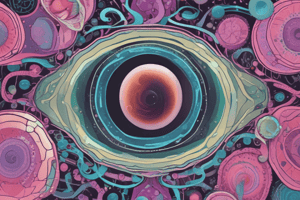Podcast
Questions and Answers
What is the purpose of the egg's nucleus?
What is the purpose of the egg's nucleus?
The nucleus of the egg is given to the sperm and then the process of gene mixing happens.
What is the process of forming twins?
What is the process of forming twins?
The female body is specifically prepared for one child but in some rare cases of twins. There are two types of twins. There are identical twins where the zygote basically splits into two first and these two go further from each other and create their own fetuses. These twins tend to be more alike. The other type of twins are called fraternal twins where by accident two eggs are produced from both the ovaries and if they both become fertilized there will be 2 babies.
Which hormone is released after ovulation and what is its purpose?
Which hormone is released after ovulation and what is its purpose?
Corpus luteum is produced in the follicle. This yellow body produces a hormone called Progesterone. Progesterone sends signals to the uterine lining/endometrium to stay healthy and thicken - This is especially useful during pregnancy - Helps get prepared for the baby and to turn into placenta
What is the function of the menstrual cycle?
What is the function of the menstrual cycle?
Signup and view all the answers
How is the menstrual cycle structured?
How is the menstrual cycle structured?
Signup and view all the answers
What is the journey of a sperm?
What is the journey of a sperm?
Signup and view all the answers
Study Notes
Pregnancy
-
Sperm's Journey:
- Sperm, containing liquid from the prostate, travels through the female reproductive system.
- It enters through the vagina and travels up the cervix.
- Many sperm die during this journey.
- The surviving sperm reach the fallopian tube where the egg is waiting.
- Only one sperm fertilizes the egg.
- Once the sperm reaches the egg, it contributes its nucleus (containing 23 chromosomes); the rest of the sperm's body is discarded.
-
Formation of the Zygote:
- The egg and sperm's nuclei combine to form a zygote (containing 46 chromosomes in 23 pairs).
- The zygote undergoes a process of gene mixing.
- Specific genes are selected, some are expressed (showing the child's traits), and others are suppressed.
- Gene mixing results in the unique combination of traits of the child.
-
Embryonic Development:
- The zygote cell divides into more cells, going through various stages.
- The cell progresses from a morula to a blastocyst, moving into the prepared uterus.
- The process of cell division stops the menstrual cycle.
-
Twins:
- A woman's body can be prepared for twins in rare cases.
- Identical twins develop when the zygote splits into two independent zygotes.
- Fraternal twins occur from the fertilization of two different eggs released simultaneously.
- Identical twins are similar (have the same traits).
- Fraternal twins can share some traits, but are not as similar as identical twins.
-
Embryonic Process:
- The blastocyst reaches the endometrium (uterine lining) where the layers and different body systems are already developed.
- Once this occurs, the structure becomes an embryo.
- Specialized cells develop in the period following fertilization through the placenta.
- The amniotic sac is formed and fills with fluid within the uterus.
Studying That Suits You
Use AI to generate personalized quizzes and flashcards to suit your learning preferences.
Description
Explore the fascinating journey of sperm as it travels through the female reproductive system, culminating in the formation of a zygote. Understand the process of gene mixing and how unique traits are established during embryonic development. This quiz covers essential stages of pregnancy from fertilization to early development.



